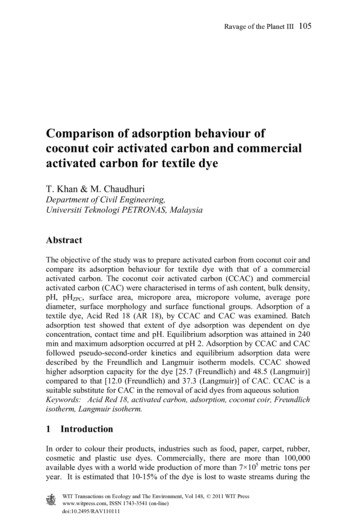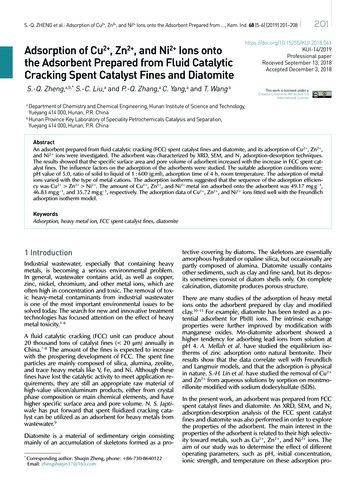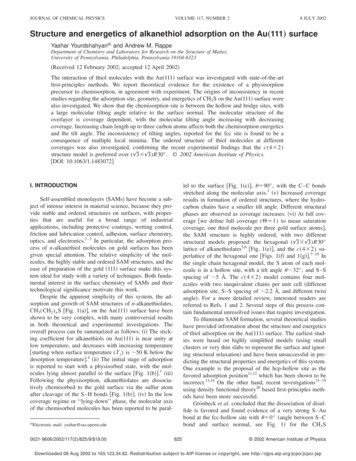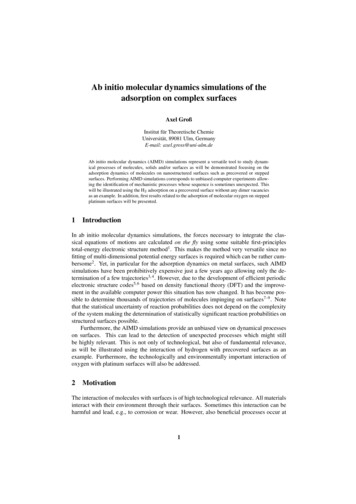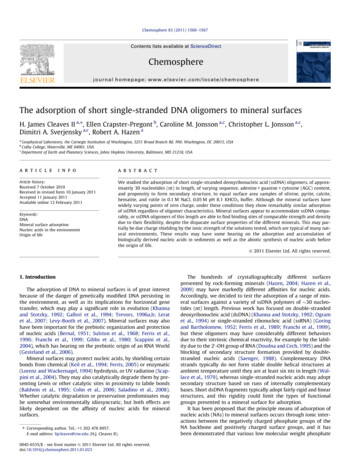
Transcription
Chemosphere 83 (2011) 1560–1567Contents lists available at ScienceDirectChemospherejournal homepage: www.elsevier.com/locate/chemosphereThe adsorption of short single-stranded DNA oligomers to mineral surfacesH. James Cleaves II a, , Ellen Crapster-Pregont b, Caroline M. Jonsson a,c, Christopher L. Jonsson a,c,Dimitri A. Sverjensky a,c, Robert A. Hazen aaGeophysical Laboratory, the Carnegie Institution of Washington, 5251 Broad Branch Rd. NW, Washington, DC 20015, USAColby College, Waterville, ME 04901, USAcDepartment of Earth and Planetary Sciences, Johns Hopkins University, Baltimore, MD 21218, USAba r t i c l ei n f oArticle history:Received 7 October 2010Received in revised form 10 January 2011Accepted 11 January 2011Available online 12 February 2011Keywords:DNAMineral surface adsorptionNucleic acids in the environmentOrigin of lifea b s t r a c tWe studied the adsorption of short single-stranded deoxyribonucleic acid (ssDNA) oligomers, of approximately 30 nucleotides (nt) in length, of varying sequence, adenine guanine cytosine (AGC) content,and propensity to form secondary structure, to equal surface area samples of olivine, pyrite, calcite,hematite, and rutile in 0.1 M NaCl, 0.05 M pH 8.1 KHCO3 buffer. Although the mineral surfaces havewidely varying points of zero charge, under these conditions they show remarkably similar adsorptionof ssDNA regardless of oligomer characteristics. Mineral surfaces appear to accommodate ssDNA comparably, or ssDNA oligomers of this length are able to find binding sites of comparable strength and densitydue to their flexibility, despite the disparate surface properties of the different minerals. This may partially be due charge shielding by the ionic strength of the solutions tested, which are typical of many natural environments. These results may have some bearing on the adsorption and accumulation ofbiologically derived nucleic acids in sediments as well as the abiotic synthesis of nucleic acids beforethe origin of life.! 2011 Elsevier Ltd. All rights reserved.1. IntroductionThe adsorption of DNA to mineral surfaces is of great interestbecause of the danger of genetically modified DNA persisting inthe environment, as well as its implications for horizontal genetransfer, which may play a significant role in evolution (Khannaand Stotzky, 1992; Gallori et al., 1994; Trevors, 1996a,b; Leratet al., 2007; Levy-Booth et al., 2007). Mineral surfaces may alsohave been important for the prebiotic organization and protectionof nucleic acids (Bernal, 1951; Sulston et al., 1968; Ferris et al.,1996; Franchi et al., 1999; Gibbs et al., 1980; Scappini et al.,2004), which has bearing on the prebiotic origin of an RNA World(Gesteland et al., 2006).Mineral surfaces may protect nucleic acids, by shielding certainbonds from chemical (Keil et al., 1994; Ferris, 2005) or enzymatic(Lorenz and Wackernagel, 1994) hydrolysis, or UV radiation (Scappini et al., 2004). They may also catalytically degrade them by presenting Lewis or other catalytic sites in proximity to labile bonds(Baldwin et al., 1995; Cohn et al., 2006; Saladino et al., 2008).Whether catalytic degradation or preservation predominates maybe somewhat environmentally idiosyncratic, but both effects arelikely dependent on the affinity of nucleic acids for mineralsurfaces. Corresponding author. Tel.: 1 202 478 8957.E-mail address: hjcleaves@ciw.edu (H.J. Cleaves II).0045-6535/ - see front matter ! 2011 Elsevier Ltd. All rights reserved.doi:10.1016/j.chemosphere.2011.01.023The hundreds of crystallographically different surfacespresented by rock-forming minerals (Hazen, 2004; Hazen et al.,2009) may have markedly different affinities for nucleic acids.Accordingly, we decided to test the adsorption of a range of mineral surfaces against a variety of ssDNA polymers of !30 nucleotides (nt) length. Previous work has focused on double-strandeddeoxyribonucleic acid (dsDNA) (Khanna and Stotzky, 1992; Ogramet al., 1994) or single-stranded ribonucleic acid (ssRNA) (Goringand Bartholomew, 1952; Ferris et al., 1989; Franchi et al., 1999),but these oligomers may have considerably different behaviorsdue to their intrinsic chemical reactivity, for example by the lability due to the 20 -OH group of RNA (Doudna and Cech, 1995) and theblocking of secondary structure formation provided by doublestranded nucleic acids (Saenger, 1988). Complementary DNAstrands typically do not form stable double helical structures atambient temperature until they are at least six nts in length (Wallace et al., 1979), whereas single-stranded nucleic acids may adoptsecondary structure based on runs of internally complementarybases. Short dsDNA fragments typically adopt fairly rigid and linearstructures, and this rigidity could limit the types of functionalgroups presented to a mineral surface for adsorption.It has been proposed that the principle means of adsorption ofnucleic acids (NAs) to mineral surfaces occurs through ionic interactions between the negatively charged phosphate groups of theNA backbone and positively charged surface groups, and it hasbeen demonstrated that various low molecular weight phosphate
H.J. Cleaves II et al. / Chemosphere 83 (2011) 1560–1567compounds desorb nucleic acids from mineral surfaces (Goring andBartholomew, 1952). At low pH the functional groups of the NAbases may also contribute to adsorption via ionic interactions(since A, C and G may acquire a positive charge below !pH 5 (Dawson et al., 1986)) if the mineral surface is negatively charged.DNA strands may be liberated from organisms in their ds form;however, it is of interest to gain a more fundamental understanding of the adsorption behavior of nucleic acids in general, and it hasbeen shown that many microorganisms preferentially uptakessDNA (Levy-Booth et al., 2007).The DNA polymers investigated quantitatively to date are ratherlong (for example Khanna and Stotzky, 1992; Gallori et al., 1994;Levy-Booth et al., 2007), and in general of lengths more of interestto horizontal gene transfer and the persistence of genetically modified organismal DNA than to prebiotic oligomer adsorption.The minerals tested here included a sulfide (pyrite, FeS2), a silicate (olivine, Mg2SiO4), a carbonate (calcite, CaCO3), and two metal oxides (rutile and hematite, TiO2 and Fe2O3, respectively). Thechoice of minerals was based on the ubiquity of these species innear-surface geochemical environments. For example, calcite is acommon evaporitic and hydrothermal mineral (Folk, 1974; Tivey,2007), pyrite is commonly found in hydrothermal deposits (Tivey,2007) and was a common component of beach sands prior to therise of atmospheric oxygen (Rutten, 1970), while olivine, hematiteand rutile are common components of modern beach sand (Folk,1974). These minerals thus address questions of nucleic acidbehavior across a wide range of settings. As there are some 4300known natural mineral species (Hazen et al., 2009), an exhaustivesurvey of mineral interactions with nucleic acids would be difficult. Nevertheless the minerals tested are likely to be representative of a wide range of common modern and prebiotic crustalmineral surfaces. The minerals chosen have considerably differentsurface properties (see Table S1), they thus also potentially presenthighly variable sites of interaction with nucleic acids. While claysare also ubiquitous surface minerals, their extremely high surfaceareas (often several hundreds of square meters per gram) make itdifficult to work with the correspondingly small amounts of material required to keep the total surface area constant in comparisonwith the coarser grained mineral types studied here.2. Materials and methods2.1. MineralsThe measured physical properties of the minerals used areshown in Table S1. Natural mineral samples (calcite, olivine andpyrite) were ground using an agate mortar and pestle, and sievedinto US standard fractions with the 200–325 mesh (74–43 lm)fraction collected. Hematite and rutile were used as supplied. Thepowders were placed into 15 mL falcon tubes and saturated withmilli-Q water to approximately one inch above the mineral surface.The tubes were rotated for 10 min at 50 rpm, then centrifuged for5 min at 4000 rpm. The liquid was then decanted from the tubes.This process was repeated twice more with milli-Q water, thenthree times with methanol to eliminate organic impurities, and finally three more times with milli-Q water to wash out the methanol. After the minerals were washed for the last time they werefrozen and lyophilized at "55 "C and 0.015 torr. After 48 h the minerals were removed, placed in separate ashed vials, capped, andweighed.Minerals were assayed for surface area via multipoint N2 BETadsorption isotherm analysis (Micromeritics Analytical Services,Norcross, GA) after surface washing and lyophilization.The purity of the minerals was assayed using scanning electronmicroscopy (SEM) using back-scattered electron (BSE) imaging and1561energy-dispersive spectroscopy (EDS) performed on a JEOL JSM6500F scanning electron microscope with a field emission gunequipped with a liquid N2-cooled sapphire Si(Li) EDS detector(EDAX) using a 15 kV operating voltage.2.2. ssDNAssDNA was synthesized and supplied by Sigma–Aldrich and thepurity was assayed and guaranteed by the manufacturer. Oligonucleotides were supplied as their sodium salts and dissolved inddH2O immediately prior to use. Given the low concentrations ofoligonucleotides used in these studies relative to the backgroundconcentration of buffer and NaCl, it is unlikely this additional sodium has much effect on adsorption. The ssDNA oligomers sequences assayed were arbitrarily chosen, ranged from 27 to 32residues in length, included all four DNA bases (A, G, C and T), wereof varying sequence and AGC content (Table S2), and are predictedto adopt various degrees of secondary structure using the RNAStructure Version 4.6 software package for ssDNA (Mathewset al., 2004) (Fig. S1).2.3. Batch adsorption experimentsAdsorption experiments were carried out by preparing aqueoussolutions containing 0.05 M KHCO3, 0.1 M NaCl, mineral (sufficientto give 0.025 m2 per reaction, see Table S1) and variable amountsof ssDNA under air in 1.5 mL snap-cap Eppendorf tubes, followedby rotation at 20 rpm using a Labnet Labroller II at room temperature (!25 "C) for 24 h. Equal surface area of mineral was used ineach reaction to be able to compare the amount of ssDNA adsorbedper m2, and control for variability in mineral affinity for ssDNA ofdifferent mineral types. The surface area of a mineral powder is inversely proportional to grain size, thus equal weights of even thesame mineral of different grain size may have widely varying specific surface areas.The 0.05 M KHCO3 solution gives a pH of !8.1, which is close tothe pH of many natural pore and surface waters including modernseawater (Baas Becking et al., 1960). This buffer was also chosenbecause it can be difficult to control the pH of small reaction volumes without buffers, even though the addition of bicarbonateintroduces the possibility that dissolved carbonate species maycompete with the adsorbant. The ionic strength of these sampleswas !0.15, comparable again to many natural pore waters, thoughlower than seawater (!0.5).We assumed that adsorption achieved equilibrium in 24 h.Measurement of these samples after 48 h were not significantlydifferent and it has been demonstrated in numerous previous studies that nucleic acid and other more complex polymer-mineraladsorption systems attain equilibrium on the order of minutes toa few hours (Romanowski et al., 1991; Gallori et al., 1994; Thimsenand Keil, 1998; Franchi et al., 2003).Concentrations of ssDNA remaining in solution were determined via UV visible spectroscopy at 260 nm in 1 cm path lengthquartz cuvettes using a Hewlett–Packard 8452A spectrophotometer blanked against a mineral sample treated equally but lackingssDNA, after sedimentation of the suspended mineral fractionusing a Savant SVC100H bench top fixed speed microcentrifugefor 10 min. ssDNA extinction coefficient (e) values at 260 nm werecalculated using Integrated DNA Technology’s calculator (http://biophysics.idtdna.com/), both directly and using the Cavaluzzi–Borer correction (Cavaluzzi and Borer, 2004; Tataurov et al.,2007), which corrects for aberrations due to sequence. The twomethods typically produce values that are within !6% of eachother and experimentally measured values.The amount of the input nucleic acid cleaved during adsorptioncould significantly alter the interpretation of data, and while it has
1562H.J. Cleaves II et al. / Chemosphere 83 (2011) 1560–1567been shown that mineral surfaces rapidly degrade RNA oligomers(Saladino et al., 2008), a study of DNA oligo interactions with awide variety of minerals in water at pH 6.8 and 90 "C for 60 minfound less than 3% degradation (Ciciriello et al., 2007). Followingthe general rule of thumb of an approximately 2-fold reductionin rate with a 10 "C reduction in temperature, it is highly unlikelythat significant cleavage occurs under the time scales investigated,in agreement with a study under similar conditions to ours by Caiet al. (2006).The data were evaluated as Langmuir isotherms by plotting thereciprocal of the equilibrium molar solution concentration versusthe reciprocal of the number of moles adsorbed m"2 to obtainthe parameters of K (Langmuir equilibrium constant), CMax (maximum amount adsorbed) and r2 shown in Table S3. Langmuir isotherms were fit using the LMMpro Version 1.06 software package(Alfisol, http://alfisol.com/soil.php?Department Software). TheLangmuir linear regression was used for curve fitting. This linearregression technique is fairly insensitive to data error, and thesolution concentrations used and large extinction coefficients ofthese molecules further render these analyses fairly insensitiveto data error.We hypothesized first that base sequence would not affectadsorption significantly. In contrast to nucleic acid monomers,where there can be significant contribution due to nucleobasefunctional group-mineral interactions (Arora and Kamaluddin,2007; Arora et al., 2007; Cleaves et al., 2010), we expected oligomer adsorption would be dominated by ionic interactions betweenthe backbone phosphate groups and the mineral surface. Consequently, we anticipated adsorption would depend primarily onlength. We hypothesized secondarily that adsorption would varygreatly as a function of mineral type, as mineral surface chargeshould influence the adsorption of the polyanionic oligomers.In Fig. 1, the adsorption isotherms for each of the mineral/oligocombinations tested are shown.It was found that the first hypothesis was generally true: sequence did not have a significant correlated effect with adsorptionstrength or maximum adsorption. Factors besides sequence, suchas the propensity to adopt secondary structure or the percentageof A G C residues (which can potentially develop positivecharges) (see Fig. S1 and Table S2) were likewise not observed tocorrelate well with adsorption in our experiments.These data are also shown as a function of mineral type in Fig. 2.3. Results and discussion3.2. Effect of mineral surface type3.1. Effect of oligomer sequenceThe second hypothesis, that mineral type would have a significant effect on adsorption was not generally found to be true, asthere were only small differences in the adsorption of the nucleicacids according to mineral type. The lack of dependence of adsorption strength on mineral type was surprising, since factors such asthe surface charge of the minerals under the conditions investigated were expected to vary widely. In natural systems this couldFor ssDNA the sequence space for the range of lengths studied(27, 29, 31 and 32 nucleotides) includes 427 429 431 432 molecules, in total some 2 # 1019 molecules. It would be impossible toexamine a truly representative sample of this population, andour discussion should thus be considered accordingly.Fig. 1. Isotherms for the adsorption of ssDNA oligomers on various minerals in 0.1 M NaCl, 50 mM pH 8.1 KHCO3. j/solid lines, pyrite, h/dashed lines, hematite, N/dottedlines, olivine, s/broken lines, calcite; D/thick solid lines rutile. Curve fits were done using Langmuir isotherms and the parameters shown in Table S2. Error bars aredominated by the estimated weighing error of the mineral powders, and are approximately the size of the symbols for olivine, pyrite and calcite.
H.J. Cleaves II et al. / Chemosphere 83 (2011) 1560–15671563Fig. 2. Isotherms for the adsorption of ssDNA oligomers on various minerals in 0.1 M NaCl, 50 mM pH 8.1 KHCO3. j/solid lines, ssDNA oligo A, h/dashed lines, oligo B,N/dotted lines, oligo C, s/broken lines, oligo D. Curves are fit to Langmuir isotherms using the parameters shown in Table S2. Error bars are dominated by the estimatedweighing error of the mineral powders, and are approximately the size of the symbols for olivine, pyrite and calcite.vary more due to the presence of multivalent cations not investigated here (Franchi et al., 2003).At pH 8.1, ssDNA molecules should be negatively charged, whilepyrite and rutile surfaces should be negatively charged (Table S1),olivine and calcite should be positively charged, and hematite islikely positively charged but may be in an intermediate state. Thereappears to be fairly uniform adsorption without regard to mineraltype, we thus hypothesize that there may be induced surfacecharge (i.e. that transient defects in the surface charge areexploited by the adsorbant), or that the flexibility and length ofthe molecules allows them to ‘‘find’’ positively charged sites onthe surface, although these may be sparse (Fig. 3). These resultsecho the findings of Keil et al. (1994) and Thimsen and Keil(1998) who showed that adsorption of pore water natural organicmatter (pNOM) varies little with mineralogy.Nucleic acid adsorption is known to be dependant on pH (Goring and Bartholomew, 1952; Khanna and Stotzky, 1992) as well ason the presence of inorganic cations (Franchi et al., 2003). Monovalent cations appear to be some 75–450# weaker than divalent cations in effecting the same degree of nucleic acid adsorption onmineral surfaces (Romanowski et al., 1991). Thus, even thoughNa and K are typically much more abundant than Mg2 andCa2 in seawater, the latter may be the principle mediators. Studiesof the effect of NaCl have shown that 0.1 M concentrations are often as effective as much higher concentrations (Romanowski et al.,1991) in mediating DNA adsorption to mineral surfaces.Although we have not studied the effects of divalent cations onthe adsorption of ssDNA oligomers here (see for example Liberaet al., 2005), as Thomson et al. (1996) pointed out, in the presenceof sufficient Na , the surface charge of the mineral can be neutralized, eliminating oligomer-mineral repulsion and making evennegatively charged mineral surfaces good adsorbents. Nguyenand Elimelech (2007a,b) have also shown that as ionic strength increases adsorption efficiency of nucleic acids increases on silicacoated with natural organic matter, which is also negativelycharged. They suggested this effect could be attributed to chargeshielding by Na overcoming electrostatic double-layer repulsionbetween nucleic acids and negatively charged surfaces.The concentrations of Na used in this study are likely below ornear that typical of most terrestrial or marine sediments. Divalentcations, in particular Ca2 (Poly et al., 2000), even though naturallylikely to be less abundant than Na , are able to neutralize negativesurface charge and mediate adsorption to an even greater extant(Libera et al., 2005; Cheng et al., 2006), further making it likely thatmineral type is not a major factor in nucleic acid adsorption exceptin very low ionic strength natural environments (Nguyen andChen, 2007).3.3. Error considerationsThe accuracy of adsorption isotherms of ssDNA oligomers musttake into account errors introduced by assumptions about extinction coefficients which are herein computed rather than directlymeasured. These errors may be as much as 5–7% (see experimental section). We use the average of 6% here. Likewise, to study afixed surface area per reaction (2.5 # 10"2 m2), the aliquotsweighed out ranged from 5 to 65 mg, and we estimate that theweighing precision is maximally 1 mg (Table S1), although this
1564H.J. Cleaves II et al. / Chemosphere 83 (2011) 1560–1567Fig. 3. A comparison of maximal adsorption of single-stranded and doublestranded oligoribo- and oligodeoxyribonucleotides on various minerals as afunction of length. D: !5 nt ss RNA (Goring and Bartholomew, 1952); s: thisstudy; d: dsDNA on kaolinite (Pietramellara et al., 1997); open diamonds: dsDNAon sand (Romanowski et al., 1991); filled diamonds: dsDNA on montmorillonite(Khanna and Stotzky, 1992); j: dsDNA on kaolinite (Franchi et al., 2003); h: riboand deoxyribonucleotides on various minerals (Cleaves et al., 2010); N: dsDNA onmontmorillonite (Franchi et al., 2003); X: dsDNA plasmids on montmorillonite(Pietramellara et al., 1997). Also shown are isotherms for ideal maximal adsorptionof ss- (solid line) and dsDNA (dashed line).is likely a high-end estimate. The surface areas present in theseexperiments thus likewise contain similar error (maximally 1–20% depending on the mineral). These values are reflected in theerror bars represented in Figs. 1 and 2. The particle size was alsovariable (Table S1), however a systematic effect of this variablewas not observed in the data.3.4. Comparison with previous workThe nucleic acid oligomers studied here are much smaller(!0.03 kilobase (kb)) than those studied previously: (2.7–23 kb)(Khanna and Stotzky, 1992; Gallori et al., 1994; Lorenz and Wackernagel, 1994; Ogram et al., 1994). These oligomers are likely onthe low side of that needed to convey genetic information in theform of functional genes (Abel and Trevors, 2006; Hoff et al.,2008). For example Ogram et al. (1994) claimed 2 kb is the minimum length for a functional gene. Such short sequences may beof sufficient length for the transfection of regulator elements, however. 30 nt oligomers may also be on the low end of the lengthneeded for a catalytic nucleic acid (Joyce and Orgel, 1999), butare likely in the size range that might be expected to accumulateunder prebiotic conditions (Verlander and Orgel, 1974). Theymay thus be considered as an intermediate length offering insightsinto the behavior of both modern and primordial molecules.The molecules studied are also single-stranded and thus moreflexible than dsDNA molecules. The flexibility of nucleic acid molecules may have a profound affect on their adsorption (Martinson,1973; Romanowski et al., 1991), which may affect, due to conformational restriction, their ability to find exposed binding sites onsurfaces (Silberberg, 1962). The adsorption of polymers of thislength is likely not affected greatly by differences in mineral porosity, though porosity seems to favor the adsorption of smaller NA’sin soils (Ogram et al., 1994). Using 8 model soils it was found thatlength was an important factor, and that there was no significantcorrelation between pH, organic content clay content or cation exchange capacity.Relatively few studies of oligonucleotide adsorption have beencarried out with well-characterized minerals, in which mineralcomposition, specific surface area and grain size are measured. Despite the difficulty in estimating surface areas for soils, clays orother minerals reported in the literature, it is apparent that adsorption ranges narrow as length increases. It is therefore likely thatvariables such as polymer length, mineral type and solution characteristics matter less as polymer length grows. The influence ofpolymer length, solution conditions and mineral type may be moreimportant for short oligomers (of relevance to prebiotic chemistry)than for longer oligomers of length relevant to horizontal genetransfer.Holm et al. (1993) found akaganeite and goethite to be approximately equal with respect to adsorption of polynucleotides, butfound hematite to be approximately 2-fold stronger. Isothermswere independent of the base composition of the polymers. Martinson suggested base composition and the folding/backbone composition have some influence on adsorption (Martinson, 1973).Langmuir adsorption isotherms become ‘‘general purpose’’when there are multiple types of adsorption sites and the molecules are large, thus averaging out interactions (Kinniburgh,1986). The adherence of experimental data to the Langmuir equation gives little information regarding the mechanism of adsorption, and any adsorption reaction with a finite distributioncoefficient can be represented by a two- or more surface Langmuirequation (Sposito, 1982). Nonetheless fitting to a Langmuir isotherm does provide a convenient method for the comparison ofadsorption phenomena.Langmuir curve fitting is not highly sensitive to data error,though Langmuir isotherms may not represent any underlyingphysical reality. It has been suggested that even multi-parameterLangmuir equations, though providing good data fits, may bemathematical oddities (Sposito, 1982). Langmuir fits were shownto be better than Jovanovich fits by Huang and Horváth (1987),and Franchi et al. (1999) also showed that Langmuir fits were generally better than Freundlich curve fits. Freundlich isotherms typically describe systems where saturation is not observed (Thimsenand Keil, 1998), unlike what is observed here.The CMax values (in moles m"2) are generally close in magnitude (!0.01–0.06 lmoles m"2), though they range over a factorof !4 (Table S3). The K values vary over a range of approximately200, indicating a marked difference in affinity of the molecules forthe surfaces, with calcite and olivine displaying the lowest values.This difference is difficult to explain based on the expected surfacecharges at pH 8 for these minerals (see Table S1). Specifically, calcite and olivine are expected to have generally positive surfacecharges while pyrite and rutile are expected to have generally negative surface charges at this pH. Thus, it is possible that the mineralstructure and the spatial distribution of surface sites is moreimportant than the overall surface charge of the mineral.There was no obvious strong correlation between CMax or K andsequence length, calculated secondary structure or % AGC contentfor any of the mineral/oligonucleotide combinations tested. Thislack of correlation suggests that all of these oligomers adsorb as extended polyelectrolytes via backbone phosphate interactions wherethe difference of a few residues makes little difference in adsorptionaffinity and there is little if any difference caused due to interactionsof the heterocyclic base residues. This result agrees well with thesuggestion of Franchi et al. (2003) that only the backbone phosphate groups are involved in adsorption, as dsNA’s require moredivalent cations to bind and thus are less strongly bound.It is of interest to compare the adsorption behavior of variouslengths of DNA on minerals surfaces. A comparison of maximaladsorption of these oligomers and other oligonucleotides data fromthe literature on various minerals as a function of length is shownin Fig. 3.
H.J. Cleaves II et al. / Chemosphere 83 (2011) 1560–1567Lazard et al. (1987) pointed out the difficulty of comparing literature values for surface adsorption phenomena, namely specificsurface areas of minerals are often poorly measured and thelengths of the polymers can vary widely, thus isotherms representaggregates of a wide polymer range over an unknown surface area.For the construction of Fig. 3 we have attempted to use only valueswhere the surface area and polymer length data are extractablefrom the data.As can be seen, although monomers often adsorb more thanwould be predicted for a monolayer, both ssDNA and dsDNAquickly deviate below the calculated monolayer adsorption coverage. A DNA double helix is !2 nm in diameter, thus a ssDNA strandshould be 1 nm in diameter when fully extended. Assuming3.4 nm/10 base residues gives extended linear molecules with anadsorption footprint of 10"17 m2. A square meter of surface areashould then be able to accommodate !170 nmoles of !30 base residue ssDNA at complete surface coverage. We note that the maximal values measured here appear to be !5–35 nmoles m"2,suggesting that there are not sufficient surface sites to adsorb thismany molecules or that the adsorbed molecules are not laid downflat and extended, but rather partially attached, coiled or looped.Free energies of adsorption of polymers tend to become negativeand polymers tend to adsorb more strongly as the number ofmonomers increases (Parfitt and Greenland, 1970), nevertheless,Pietramellara et al. (1997) found adsorption decreased withincreasing molecular weight on montmorillonite and kaolinite.Macromolecules adsorbing onto surfaces from solution typicallyuncoil into more extended forms (Theng, 1974), which has beenimaged for both ssDNA and ssDNA on various minerals usingAFM (Bezanilla et al., 1995; Hansma et al., 1996). This is a reasonable explanation for the observed adsorption behavior.Once long molecules adsorb they are essentially irreversiblyadsorbed due to the improbability that adsorbed ‘‘trains’’ willsimultaneously desorb (Collins et al., 1995). These authors alsosuggested compounds need a minimum of three reactive groupsto be extended on surfaces (a criterion met by NAs), thus adsorption favors long polymers as well as the condensation and preservation of these. This factor could partially explain whysedimentary organic matter has roughly a monolayer of adsorbedcarbon (Keil et al., 1994; Collins et al., 1995).Alvarez et al. (1998) showed that DNA adsorbed on kaoliniteand montmorillonite can be amplified by PCR, which also is compatible with the loop and train model, and suggests that portionsof the NA
umes without buffers, even though the addition of bicarbonate introduces the possibility that dissolved carbonate species may compete with the adsorbant. The ionic strength of these samples was !0.15, comparable again to many natural pore waters, though lower than seawater (!0.5). We assumed that adsorption achieved equilibrium in 24 h.


